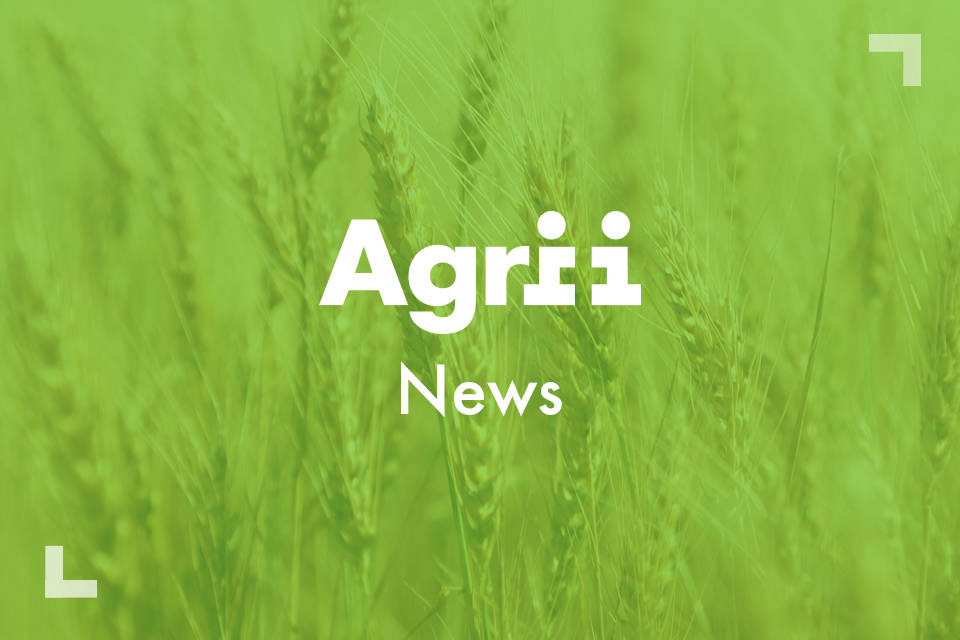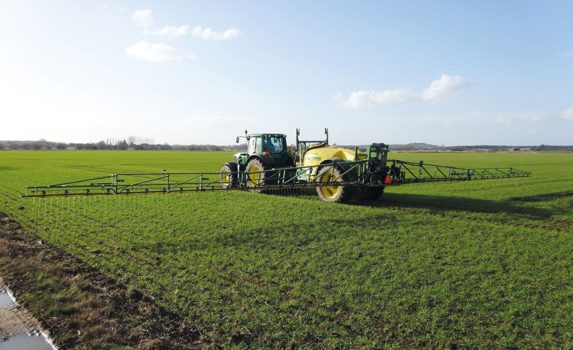
Fuelling Growth with Liquid Fertiliser
News - 06.03.24
Agrii Tramlines Podcast | Season 3, Episode 24
Agriculture is changing bringing new opportunities for growers.
Below is a summarised transcript for our recent Tramlines Podcast episode talking about about the benefits of liquid fertiliser systems and applications for your farm and the wider environment.
How can liquid fertilisers help us balance the needs of the crop with the needs of the environment?
What are the right choices that will fit with farming regimes for both arable and livestock farmers?
Farmer, Nick Bumford is alongside Agrii's Rob Willey and host Tony Smith.
Featured in this Episode

Rob Willey
National Fertiliser Commercial Manager

Nick Bumford
Farms Director, Guiting Manor Farms
Why Liquid Fertiliser?
[Rob]
Well, I suppose you can start off by saying what is liquid fertiliser? And it's a stable, clear liquid manufactured using urea, ammonium nitrate. And in the next grades, inclusion of ammonium sulphate. So it's very stable. It's ideal for storage and application.
What are the overall benefits for the farmer and grower?
[Rob]
Well, in terms of the fertiliser, a good proportion of that nitrogen is in the ammonium form, which is really useful because it means it has a positive charge and it remains stable in the soil.
In terms of the product, the advantage is economically, it's a very strong proposition. In terms of other benefits for the liquid system, there are many but certainly one of the key ones would be the accuracy of application. That would be one of the key ones that many people who move from a solid to a liquid system would suggest.
As a farmer that's using liquid fertiliser, can you tell us a bit about the crops that you're growing and got in the ground this season?
[Nick]
We're growing oilseed rape which is typically followed with the first wheat. We don't grow a second wheat and instead of second, we elect to grow either winter or spring malted barley. And we also grow a catch crop while sheep flock in between winter barley and spring barley which is stubble turnip.
And on which crops are you using Liquid fertiliser?
Can you summarise, what is the overall benefit for you as a farm business?
[Nick]
We’ve been with liquid fertilisers for well over 30 years now, and don’t use solid nitrogen on any of our arable crops. We like the ease of the product in terms of how easy it is to store, handle and apply and apply with a very high level of accuracy.
If you look at a typical crops sprayer that's well maintained as they have to be, the coefficient of variation on that is less than 2% and if you look at a solid fertiliser spreader, even a well maintained and calibrated one would be typically 5 to 7% accuracy.
And that's before you start to interact with things like slope factor and, wind and rainfall, which of course impacts heavily on solid fertiliser but not on liquid.
[Rob]
Absolutely. And particularly accurate placement and application to the field margin, that's really important because using a sprayer, you're going to be able to apply right to that field edge.
And typically an average, though it's very difficult to talk about average farms, but an average farm may well have 10% of their farm be headlands, which is challenging to farm.
And you're always going to have an impact in terms of yield when using solid fertiliser, which you won't get using liquid because of that accuracy of spraying.

SAM3 SFI Multi-species leys
Read MoreSo that accuracy of placement right to that headland is not just about yield, what are the other benefits?
[Nick]
Well, as a farmer that has an eye on what we call integrated conservation, so let's define what integrated means. If you have a large area of arable fields and you have a boundary structure or you have woodland edge or water edge.
Most farmers have some or all of those. Then essentially what you don't want to be doing is putting anything that would damage the biodiversity into any of those adjoining features.
And with liquid fertiliser, you’re on a vertical placement and there's no lateral shift and hence there's no fertiliser entering the field margin or buffer zone or any of those habitats.
So wildlife habitats and the crop helps to support wildlife habitats, but they're so important to the biodiversity on any farm or given area of land.
Accurate placement helps you improve performance and protect the environment. Are there any other benefits that you've noticed when using liquid fertilisers over the years?
[Nick]
Yes. The first obvious benefit is that with solid fertilisers, once you've opened the bag, you can’t easily return it to the bag because it's in the hopper and it's just not easy to handle.
With liquid you never have any product that you have to get rid of because you just pop it back into the tank.
And the other thing is it doesn't go off overnight or change. You can store it indefinitely in a tank, whereas solid fertilisers if they are subjected to either rainfall or high humidity, then they start to melt and you can end up with some challenging problems.
And of course, the other one would be the ease of delivery/product intake, so you don't have to be on site when the tanker arrive.
The tanks come in, they unload the tank, which are always kept secure for obvious reasons. They pump into the tank and they give you they leave a delivery note.
So in terms of time efficiency, of course you can make the lorry, but you don't need to and you don't have any bags or anything to dispose of. So that works really well.
How does a farmer get that infrastructure set up to be able to use liquid fertiliser?
[Rob]
If the farmer decides that a liquid fertiliser system could be useful for them, first of all, you need to look at that storage infrastructure. Agrii do supply tanks for those farmer customers to be sited on their farms so that they can hold that product through the season.
And it's very important that those tanks are sited appropriately so that there isn't any potential environmental impact.
And we're looking at aquifers and the correct position on the farm to make sure that's correct. The farmer would then need to put down a concrete base around which they would need to be bunding erected and then the tanks are placed within that bunding to ensure that there is safety, both in terms of should there be any leak with the tank, that there is somewhere to hold that fertiliser. But also actually those bunds act as a bit of a bit of a safety net around that, because most damage to tanks comes from machinery and in the farmyard. It stops anything getting close to that tank to cause it damage.
Once you've got the tank infrastructure there, you'll need to buy that fertiliser. And that's an important part of the process because you will only have storage for a certain percentage of your usage. And the important thing is you'll buy some to be filled up into the autumn and then you'll have a more ‘just in time’ system for the product you require through the spring.
So that's so important that your supplier is able to make those deliveries on time to make sure it doesn't hinder applications through the spring.
[Nick]
And I know I like the fact that I don't need to have a forklift tied up unloading and putting solid materials into my precious building space, which can be used for other things. So, you know, that's quite a big consideration from a from a delivery and storage perspective. It's what I would call seamless really.
Using liquid fertilisers means you're not having to store granular fertiliser in your precious buildings. Does that also mean you're not tying up valuable capital?
[Nick]
Well, let's talk about the other end, which is the offtake. So you'll need a home, the pump or the equivalent of your need a good sprayer and you'll probably need a bowser, unless your tanks are very central and you're going to all the fertiliser in the sprayer.
But the ability to own maintain and run a fire, if it's being used for liquid fertiliser as opposed to a solid fertiliser applicator on the back of a tractor, means that there is an opportunity to save in terms of capital investment or justification of buying a better sprayer.
And, you know, let's not lose sight of the importance of the modern crop sprayer by which, you know, which is the biggest influence or driver of crop yield. Being able to apply accurately and timely of any product that the crop requires during the growing season. And if you're using liquid fertilisers as part of the system, you can actually justify a better sprayer which benefits the whole system.
[Rob]
I think that's really important. We mentioned about the catalyst for moving to a liquid system, and I think that's probably one of the biggest when a farmer is considering changing his sprayer, there's a really good opportunity to consider looking for a sprayer that will be a dual function and be able to move to that liquid system.
What changes are coming into force and what does this mean for growers?
[Rob]
Post the 31st of March 2024. There's a requirement to use an inhibitor in conjunction with liquid fertiliser as it contains urea, and that would be policed under the red tractor scheme. That's to limit losses through the lateralization to the atmosphere as the weather warms up through the spring.
In practical terms, what does this mean to the farmer?
[Nick]
It means more attention to detail. We’ve already been working with a product called Liqui-safe and therefore we had confidence that the product works and we've been using it to reduce the lateralization. And, you know, I would say, why wouldn't you?
Because if you're buying nutrient to apply to a crop, you want it to be available for your crop. The legislation is now a driver, but before that it was a choice. So we last year we used it commercially on all of our crops and we had good results.
[Rob]
I think that's right, Nick, And I think one of the key bits is collateralization. There are other pathways where nitrogen is lost equally and that's through nitrification and leaching.
And one of the key periods of loss can be through leaching. So Liqui-Safe as a product it's key differentiator is that it acts on those three pathways and that makes it different from other products on the market.
But the difference this year is that there is a requirement for use, previously it's been an economic tool which a growing number of farmers are utilising.
[Nick]
And in the end the liquid is in. It's as simple as anything really, said people shouldn't get hung up on the detail. They just actually need to decide which products they are running with and the required amount of the tank.
Is Liqui-Safe proven to work?
[Rob]
Yes. Proven technology that we have trailed for at least five years and we've seen consistent yield increase and that's because it's keeping the nitrogen stable in an area of the soil where it can be utilised by the crop.
Where to get advice about liquid fertiliser systems, infrastructure and set up costs.
[Rob]
Well, I would always say talk to your local Agrii agronomists or Crop Input Specialist. They will have other customers who are on liquid fertiliser systems and they'll be able to advise as to whether that system would be appropriate in any given situation.
What to consider when thinking about a liquid Fertiliser system
[Nick]
Well, it's quite simple, really. Either buy or rent the tanks, get them installed professionally and be aware of any nozzle or jet stream changes that you need to adapt to the sprayer.
So you don't need anything special about the sprayer, just need to change the nozzles which all sprayer operators are aware of anyway, which is something they normally do you get.
You will have to buy some different type of nozzles for the fertiliser applications, be aware of applying it in the right conditions and, also rinse the square off. At the end of the day.
I mean, I've had all sorts of scaremongering over the years about liquid fertiliser damage in the sprayer. Not true, but a good operator will always quickly rinse his machine off at the end of the day, it takes minutes and it only needs water.
And the other one is scorching and damaging to the crops. I mean, that's on the whole just down to the operator running in inappropriate conditions and the ability to apply liquid fertiliser in a range of conditions is much more flexible than with solid fertilisers.
We quite often go when it's raining and so on. As long as the field is dry enough to carry where you wouldn't be applying fertilisers of solid nature, you can readily and comfortably apply in the rain or if it's a bit windy out, which would affect the spread pattern of solid fertilisers. The liquid is a vertical placement system and is not distorted by winds unless they're above a certain level.
So lots of benefits there to reap from liquid nitrogen.
How would you summarise the overall benefit to the farm business?
[Nick]
We benchmark crop performance locally and regionally and our crops are performing in the top quartile of what you would expect nationally, so that’s good, a good position of strength.
And I work on the premise that maintaining yield or farming for optimum output, which yield is a large component of, is vitally important because it then dilutes all the output of the other course.
What is your one key take away?
[Rob]
I'd certainly consider using an inhibitor prior to the 31st of March and obviously afterwards is a requirement, to maximize and make best use of the applied fertiliser for sure. And I think that that's the key tip for this season.
Join Our Community

Agrii X
We love engaging with clients and partners. Give us a follow and let's share stories for the community.

Agrii Instagram
A picture paints a thousand words. Follow us on Instagram to see what we are up to.

Agrii Facebook
Follow us on the worlds biggest social media site for the latest news and events straight to your feed.

Agrii LinkedIn
If you are all about the business, connect with us on LinkedIn to build your network
Stay In Touch

Newsletter Sign-Up
Receive email updates on topical news and information from around Agrii and UK Farming.

Listen To Our Podcasts
Listen to the Tramlines Podcast. Fortnightly chat about agriculture and trials with your host Tony Smith.

Agrii Insights
Read essential agri intelligence for profitable farming.

Find an Event
Join us for our upcoming events and tours.



